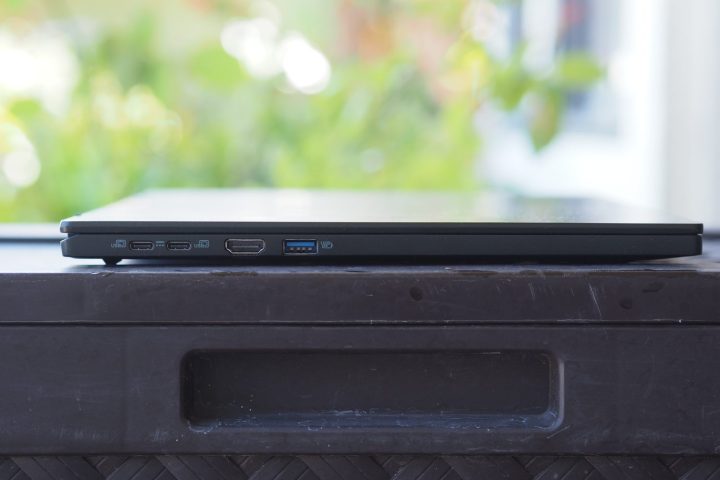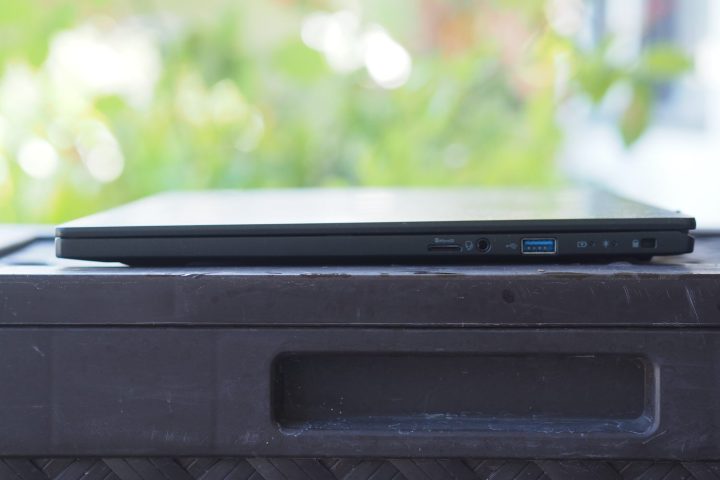Acer Swift Edge 16
MSRP $1,300.00
“A gorgeous 16-inch OLED display and svelte profile make the Acer Swift Edge 16 an outstanding value.”
Pros
- Strong productivity performance
- Superior OLED display
- Thin and light
- Comfortable keyboard and touchpad
- Attractive price
Cons
- Chassis and lid a bit flexible
- Poor battery life
- Only one configuration available
The 16-inch laptop has mostly replaced the 15-inch laptop as the most popular large machine. Both are close enough in size that we generally lump them together, but that doesn’t mean that all 16-inch laptops are the same. They’re not, with a distinct delineation between high-powered machines aimed at creators and thinner, lighter, and less powerful laptops intended for less demanding productivity users.
The Acer Swift Edge 16 falls into the second group, which focuses more on a thin and lightweight chassis that doesn’t allow for powerful components like discrete GPUs. There are fewer of these machines, and the Swift Edge 16 offers just enough to make it a leader among its peers.
Specs and configurations
| Acer Swift Edge 16 | |
| Dimensions | 14.08 inches x 9.68 inches x 0.57-0.60 inches |
| Weight | 2.73 pounds |
| Processor | AMD Ryzen 7 7840U |
| Graphics | AMD Radeon 780M graphics |
| RAM | 16GBLPDDR5 |
| Display | 16-inch 16:10 WQXGA+ (3,200 x 2,000) OLED, 120Hz |
| Storage | 1TB PCIe Gen4 SSD |
| Touch | No |
| Ports | 2 x USB4 2 x USB-A 3.2 Gen 1 1 x HDMI 2.1 1 x 3.5mm audio jack 1 x microSD card reader |
| Wireless | Wi-Fi 6E and Bluetooth 5.1 |
| Webcam | 1440p |
| Operating system | Windows 11 |
| Battery | 54 watt-hours |
| Price | $1,300 |
Acer currently offers just one configuration of the Swift Edge 16. For a list price of $1,300 at Best Buy (currently on sale for a very attractive $1,000), you get an AMD Ryzen 7 7840U CPU, 16GB of RAM, a 1TB SSD, a 16-inch WDXGA+ OLED display at 120Hz, and integrated AMD Radeon 780M graphics. The list price is attractive for the class of machine, and the sale price is a steal if you can get it.
A thin and light design, but not groundbreaking
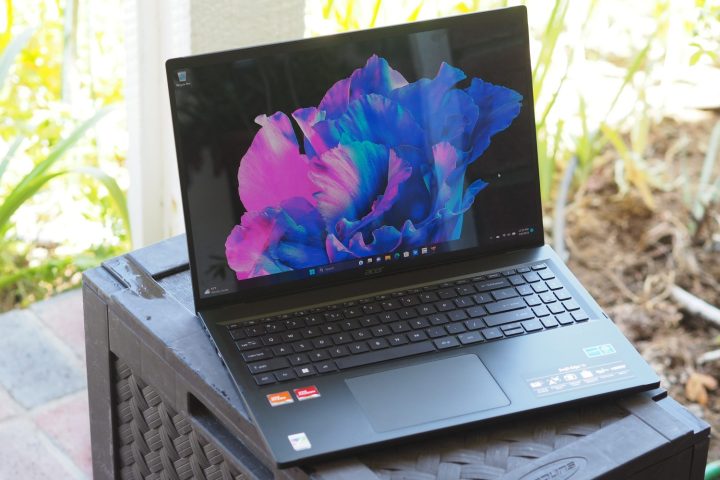
The Swift Edge 16 is clearly aimed at users who want a large display,but don’t want a large laptop. And it succeeds, being just 0.60 inches at its thickest point and weighing a very light 2.73 pounds. It’s not the thinnest or lightest 15- or 16-inch laptop you can buy. That record belongs to the Apple MacBook Air 15, which is an incredibly thin 0.45 inches and just slightly lighter at 2.7 pounds. Of course, the Swift Edge 16 does offer a larger display. The Dell XPS 15, which is a more powerful laptop that also aims to be thinner and lighter than most, is thicker at 0.70 inches and quite a bit heavier at 4.23 pounds.
Acer managed to make the Swift Edge 16 so light by using a magnesium-aluminum alloy in its chassis and lid. That tends to be considerably lighter than the straight aluminum used in Apple’s and Dell’s machines, but it’s also not as rigid. Where the MacBook Air 15 and XPS 15 both feel quite solid, the Swift Edge 16 has some flexing in the keyboard deck and twisting in the display. The Acer doesn’t feel cheap by any means, but it doesn’t have the same dense feel of quality that you’ll find on some of the competition.
Aesthetically, the Swift Edge 16 is an attractive laptop, but it doesn’t quite stand out. It follows the contemporary minimalistic theme, with simple lines and only a chrome Acer logo on the lid breaking up the black color scheme. The XPS 15 is more attractive and modern with its tiny display bezels, while the Swift Edge 16 has slightly larger bezels that are still quite thin, but they’re plastic and thus don’t come across as premium.
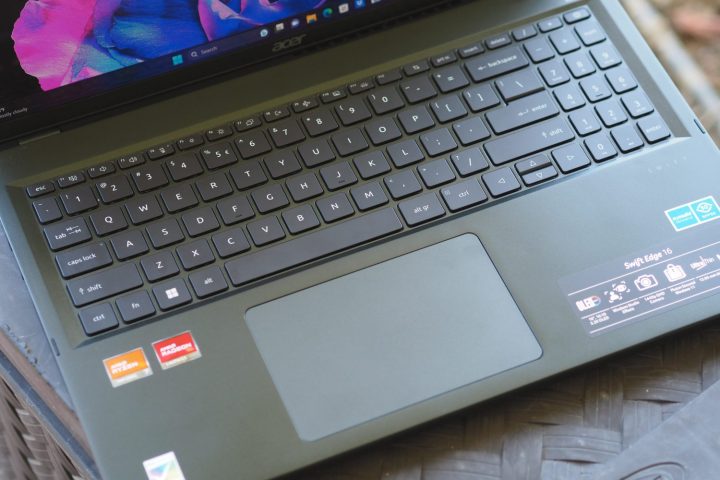
The crisp keyboard features a comfortable bottoming action, with plenty of key spacing and large keycaps. It’s not the best keyboard I’ve tested, such as the Magic Keyboard on the latest MacBooks, but it’s better than most. The touchpad is precise and responsive, with sharp, quiet button clicks, but it could be larger given the available space on the palm rest.
In terms of connectivity, the Swift Edge 16 manages to fit in a bunch of legacy support. It has a couple of USB-A ports and an HDMI 1.2 port to go with a pair of USB-C ports and a microSD card reader. The primary omission is Thunderbolt 4 support, but that’s due to the AMD chipset. Wireless connectivity is up to date.
Finally, Acer fit in a 1440p webcam that provides a sharp image for videoconferencing. That’s quadruple the resolution of the XPS 15’s 720p webcam. The Swift Edge 16 doesn’t have an infrared camera for Windows 11 facial recognition, but instead relies on a fingerprint reader embedded in the power button. The hardware didn’t work in my review unit, but hopefully that’s just an issue with the machine I tested and not a widespread problem.
A fast performer without the usual AMD longevity
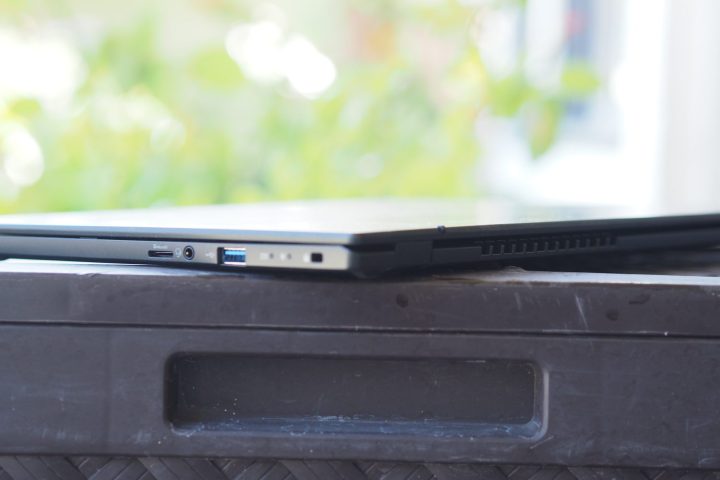
The Swift Edge 16 uses a newer AMD processor that we haven’t reviewed in another laptop. The Ryzen 7 7840U is a midrange CPU running at 28 watts, with eight cores and 16 threads at a Max Boost Clock of 5.1GHz. At that power rating, it directly competes with Intel’s 28-watt 13th-gen Core processors, primarily the Core i7-1360P with 12 cores (four Performance and eight Efficient) and 16 threads, with the Performance cores running at up to 5.0GHz.
The thing is, according to a couple of our benchmarks, the Ryzen 7 7840U is significantly faster than the Core i7-1360P. In fact, it competes better against Intel’s 45-watt Core i7-13700H with 14 cores (six Performance and eight Efficient) and 20 threads. For some reason, the Swift Edge 16 couldn’t complete the Geekbench 5 or 6 benchmarks, so I was a little limited in making comparisons. The Dell XPS 15 was slightly faster in these CPU-intensive benchmarks and benefits from a discrete GPU that will give it even better performance in creative apps like Adobe’s Premiere Pro. Acer implemented a new thermal design in this generation that provides about 10% better airflow, which seems to have helped in its performance.
The Swift Edge 16 was also faster than the Apple MacBook Air 15 with the M2 processor featuring eight CPU cores and 10 GPU cores, at least in these CPU-intensive benchmarks. In apps that can leverage the GPU, the MacBook is likely to be faster thanks to optimizations built into Apple’s Silicon chips. The Swift Edge 16’s AMD Radeon 780M graphics were faster than Intel’s integrated Iris Xe, but not by much.
Overall, the Swift Edge 16 held its own both against equally powered Intel chips and faster variants. It’s a productivity powerhouse, able to meet the most demanding workflows, but it will not please creators who benefit most from a faster discrete GPU. And gamers shouldn’t bother.
| Geekbench (single/multi) |
Handbrake (seconds) |
Cinebench R23 (single/multi) |
PCMark 10 Complete |
|
| Acer Swift Edge 16 (Ryzen 7 7840U) |
Bal: N/A Perf: N/A |
Bal: 86 Perf: 84 |
Bal: 1790 / 10560 Perf: 1788 / 10848 |
6648 |
| LG Gram 17 Pro (Core i7-1360) |
Bal: N/A Perf: N/A |
Bal: 108 Perf: 103 |
Bal: 1860 / 9586 Perf: 1875 / 10063 |
6839 |
| Dell XPS 13 Plus (Core i7-1360P) | Bal: 1652 / 7640 Perf: 1726 / 9098 |
Bal: 123 Perf: 100 |
Bal: 1512 / 7417 Perf: 1705 / 9895 |
5305 |
| Lenovo Yoga 9i Gen 8 (Core i7-1360P) |
Bal: 1650 / 8080 Perf: 1621 / 8544 |
Bal: 122 Perf: 101 |
Bal: 1846 / 8779 Perf: 1906 / 9849 |
5537 |
| Dell XPS 15 (Core i7-13700H) |
Bal: 1,787 / 11,978 Perf: 1,830 / 11,769 |
Bal: 79 Perf: 76 |
Bal: 1,865 / 13,386 Perf: 1,868 / 13,927 |
7047 |
| Acer Swift X 14 (Core i7-13700H) |
Bal: 2271 / 12523 Perf: 2256 / 12439 |
Bal: 74 Perf: 83 |
Bal: 1713 / 10611 Perf: 1714 / 12335 |
6914 |
| Lenovo Slim Pro 9i 14 (Core i7-13705H) |
Bal: 2559 / 12272 Perf: 2560 / 13335 |
Bal: 91 Perf: 74 |
Bal: 1913 / 14024 Perf: 1906 / 15608 |
6976 |
| Apple MacBook Air 15 (M2) |
Bal: 2606 / 10024 Perf: N/A |
Bal: 144 Perf: N/A |
Bal: 1596 / 8020 Perf: N/A |
N/A |
Perhaps it’s the small 54 watt-hour battery and the power-hungry, high-resolution OLED display running at 120Hz, but the Swift Edge 16 didn’t get the kind of battery life we usually see with AMD processors. The Ryzen 7 7840U isn’t as low-power as the 15-watt alternatives, but is uses less power than the 45-watt machines it best competes with. But whatever the reason, it didn’t last very long in our benchmarks.
It went for just 5.75 hours in our web-browsing test, which is well below average, and the same held true with the PCMark 10 Applications battery test that gives an idea of productivity battery life. In that test, it managed just 6.75 hours, whereas most machines come in at around 10 hours. Finally, in our video-looping test, which is the least computing-intensive, but is most impacted by the display technology, the Swift Edge 16 lasted for just 6.5 hours, which is a very poor score.
The laptop isn’t likely to last until lunch, let alone a full day. You’ll need your power adapter if you’re going to be out of the office or away from home.
A top-notch OLED display
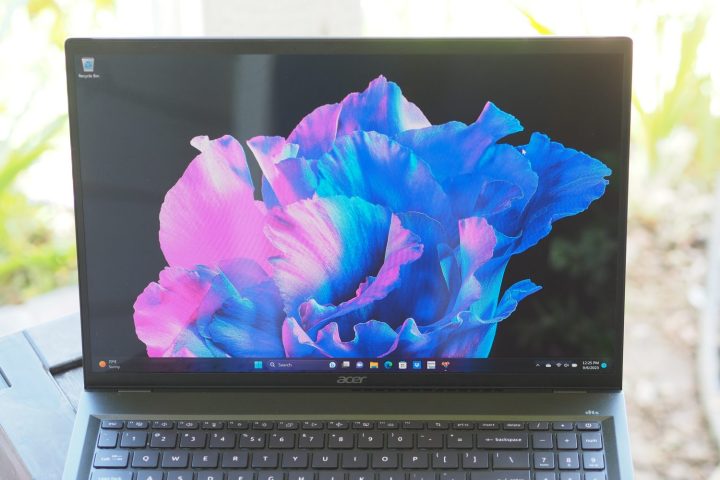
The Swift Edge 16 has a sharp OLED display running at 16:10 and 3,000 x 2,000, with a refresh rate of up to 120Hz. It’s a bright and beautiful display out of the box, with inky blacks and excellent colors. That’s my subjective opinion.
My colorimeter agreed. The display is bright at 416 nits, with incredibly wide colors at 100% of both sRGB and AdobeRGB and 99% of DCI-P3. Accuracy was also superior, at a DeltaE of 0.63 (anything under 1.0 can’t be seen with the naked eye). As with several OLED displays I’ve tested, my SpyderX Elite colorimeter didn’t return results for the contrast ratio, but I’m certain it’s as high as all OLED panels.
While the Swift Edge 16 doesn’t have the sheer performance creators need, it certainly has the display for creative work. It’s also excellent for productivity users and media consumers.
A solid entry in the thin-and-light 16-inch sweepstakes
If you’re looking for a fast productivity laptop with a beautiful display, the Swift Edge 16 is a solid choice. It’s incredibly thin and light — not quite as thin as the MacBook Air 15, but much thinner than most 16-inch machines.
It’s not perfect, though. Its graphics performance isn’t great, and its battery life is poor. Balanced against that is an attractive list price and an incredible sale price. The Swift Edge 16 is recommended for anyone who wants a larger display, but not a larger laptop.
Editors’ Recommendations


